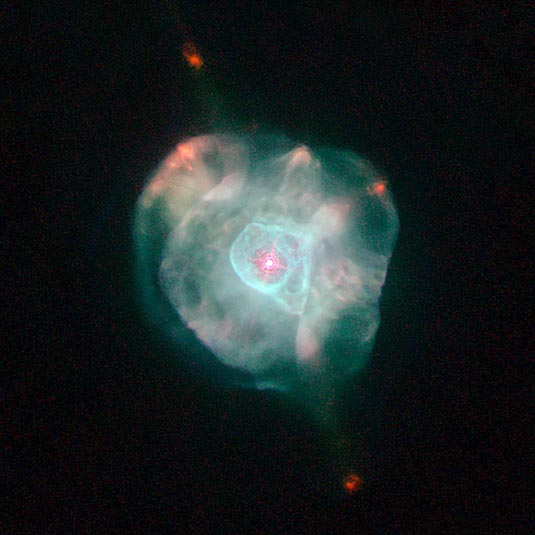
Name:
IC 4593, White Eyed Pea
Description: Planetary nebula
Position (J2000): RA 16h 11m 44.50s
Dec +12° 04' 17.00"
Constellation: Hercules
Distance: 7,900 light-years (2.42
kpc)
Visual Magnitude: 11.0
Apparent Dimensions: 12 arcsec (0.7
light-years)
Instrument: WFPC2
Exposure Date(s): February, 2007
Image Credit: NASA, ESA & the
Hubble Heritage Team (STScI/AURA)
Release Date: September 11, 2007
ABOUT THIS IMAGE:
The colorful, intricate shape of this NASA Hubble Space Telescope image reveals how the glowing gas ejected by dying Sun-like stars evolves dramatically over time.
This gaseous cloud, called a planetary nebula, is created when stars in the last stages of life cast off their outer layers of material into space. Ultraviolet light from the remnant star makes the material glow. Planetary nebulae last for only 10,000 years, a fleeting episode in the 10-billion-year lifespan of Sun-like stars.
The name planetary nebula has nothing to do with planets. They got their name because their round shapes resembled planets when seen through the small telescopes of the eighteenth century.
This series of Hubble images show the evolution of planetary nebulae, revealing how they expand in size and change temperature over time. A young planetary nebula is small and is dominated by relatively cool, glowing nitrogen gas. In the Hubble images, the red, green, and blue colors represent light emitted by nitrogen, hydrogen, and oxygen, respectively.
Over thousands of years, the clouds of gas expand away and the nebulae become larger. Energetic ultraviolet light from the star penetrates more deeply into the gas, causing the hydrogen and oxygen to glow more prominently. In the older nebulae, such as IC 4593 hydrogen and oxygen appear more extended in these regions, and red knots of nitrogen are still visible.
This planetary nebula imaged by the Hubble Space Telescope lies in our Milky Way Galaxy. It's distance from Earth is about 7,900 light-years. The snapshot was taken with Hubble's Wide Field Planetary Camera 2 in February 2007. Like snowflakes, planetary nebulae show a wide variety of shapes, indicative of the complex processes that occur at the end of stellar life.
This image of IC 4593, a planetary nebula in our Milky Way galaxy shows a prominent pair of jets on opposite sides of the central star, ending in bright red knots due to relatively cool nitrogen gas. IC 4593 is in the northern constellation Hercules. The bluish-green color shows the overall high level of excitation of the gas in this nebula.
This
image is a composite of many separate exposures made by the WFPC2 instrument
on the Hubble Space Telescope. Three filters were used to sample narrow
wavelength ranges. The color results from assigning different hues (colors)
to each monochromatic image. In this case, the assigned colors are:
F502N ([O III])
blue Oxygen
F656N (Halpha) green
Hydrogen
F658N ([N II])
red Nitrogen